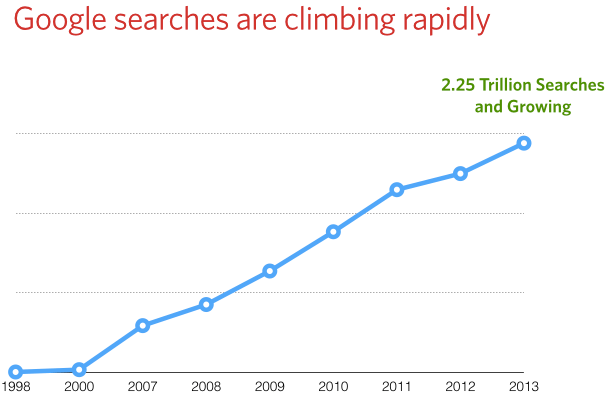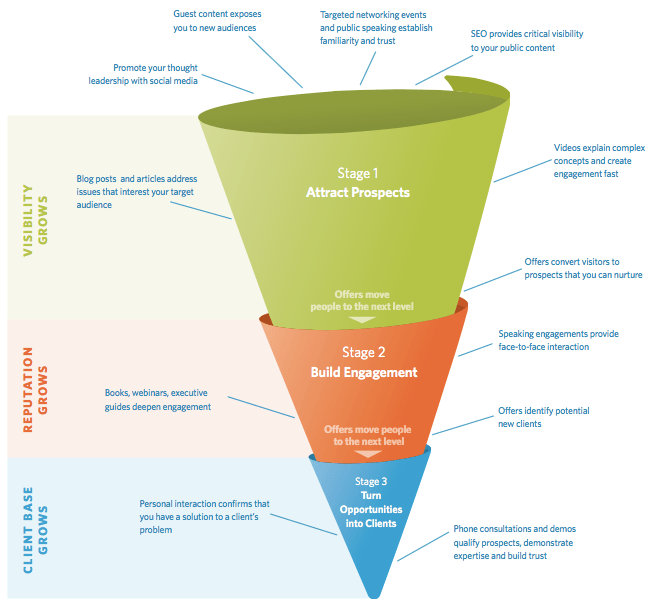While there are many opinions on what technology marketing strategies work best when it comes to generating and nurturing leads, what’s not up for debate is this: today, the majority of prospective clients are looking for their information online first – before they’re receptive to any human interaction.
Consider the 2.25 trillion searches Google reigned in last year.

This, of course, is not the foundation around the notion that online search is how buyers are educating themselves. Rather, it’s just one of the indicators of a shift in the marketplace. We know from our own research that 80% of people who buy professional services will go online to educate themselves before they will take any other action.
In response, professional services firms are building entire technology marketing strategies around ensuring they’ve got enough online content to feed their information hungry audience, creating a content funnel. This post will focus on the funnel, what belongs where and what prospects are willing to do at the different stages.
But first, there are a few overarching guidelines that must be incorporated in any thinking around producing content:
- No promotional topics or sales pitches in the content
- Make sure you have a genuine pulse on your space so you produce content around solving your audience’s problems
- Keyword optimization matters
- Planning also matters – never start, and then stop!
- Build on a content strategy to ensure synergy and flow of topics, which allows you to leverage every ounce of effort you put toward creating content
- That same strategy will also ideally define appropriate channels for showcasing your content
Once firms understand the rules of engagement, they can build their content funnel. There may be some nuances in particular content funnels from firm to firm, but broadly speaking, content funnels help define which types of content will be required at which stages of your prospective clients’ decision making processes. This ideally moves them from their starting point at the top of the funnel, down to the tip, where they are most likely to become a client. See the graphic below.

Think of your prospective buyers as existing in three broad categories:
1.Top of the Funnel
These are most likely prospects who don’t yet have a formal relationship with you and who are simply not willing to invest more than a couple minutes of their time in getting to know more about you and how you might potentially solve whatever it is that keeps them up at night.
But be warned: content, however valuable it may be, that sits behind a gated wall (registration form) is a big turn off at this stage. And, as the funnel suggests, you’ll need the biggest arsenal of content at this stage in order to cast your content net as widely as it makes sense for you to do. You’ll want to make most of your content easily accessible, not requiring a form, and easily found on search engines.
Most suitable content: blog posts and short articles, case studies, educational emails that might showcase data, blog round up etc., and press releases
2.Middle of the Funnel
Once you’ve captured the attention of your prospect and given them a flavor for what it might be like to work with you, they’re enticed to learn more. And at this stage, in the name of learning more, they’re also more willing to exchange a small amount of information such as an email address.
At this level, it’s perfectly fine to have more substantial content sit behind a registration form. But don’t go overboard – some firms make the mistake of asking for too many pieces of information on a single form and lose the prospect. The more detailed, “sales-qualification” information you require, the fewer downloads you are likely to get.
And when you require registration, make sure the follow up content you deliver is not superficial or self-serving. That would destroy the trust you have worked to build.
Most suitable content: executive guides, webinars, videos (not your firm video – here we’re talking about videos that demonstrate your thinking around a particular concept, like post-webinar recordings)
3.Tip of the Funnel
Prospects at this stage loyal fans and trust your firm. They’ve likey been interacting with your BD team and have shown interest in taking things further. Firms will want to make sure they have a stock of substantial content that convinces prospects at this stage of expertise and thought leadership. Content at this stage is registration form worthy, and while the content built for the top and middle funnel prospects might touch on or allude to your secret sauce, the content at this stage will fully explain it.
And by the way, giving away your secret sauce nurtures like nothing else. The opposite – guarding it closely only for those who actually award you business – dramatically decreases the volume of prospects you’ll lead from top to tip of the funnel. They’ll find another firm who gives it away for free, before they have to commit formally to the relationship.
Most suitable content: white papers or very technical journals, signature research reports, ebooks.
The process of building your own content funnel doesn’t have to lead you through a complex matrix of decisions around content. But thinking through your marketing approach in the context of a content funnel will help ensure you’re meeting the needs of each prospect persona at the different stages of their buying and decision making process.
Download our (free) Content Marketing Guide below to learn more about implementing a content marketing strategy for your firm.
On Google+ or LinkedIn? Follow us +HingeMarketing and join us on LinkedIn.


